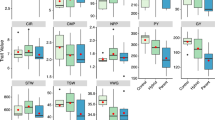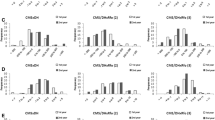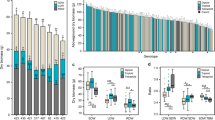Abstract
Over the last three decades, broccoli (Brassica oleracea L., Italica Group) hybrids made by crossing two inbred lines replaced open-pollinated populations to become the predominant type of cultivar. The change to hybrids evolved with little or no understanding of heterosis or hybrid vigor in this crop. Therefore, the purpose of the present study was to determine levels of heterosis expressed by a set of hybrids derived by crossing relatively elite, modern inbreds (n = 9). An additional objective was to determine if PCR-based marker derived genetic similarities among the parents can be useful to predict heterosis in this crop. Thirty-six hybrids derived from a diallel mating design involving nine parents were evaluated for five horticultural characters including the head characteristics of head weight, head stem diameter, and maturity (e.g., days from transplant to harvest), and the plant vigor characteristics of plant height, and plant width in four environments. A total of 409 polymorphic markers were generated by 24 AFLP, 23 SRAP and 17 SSR primer combinations. Euclidean distances between parents were determined based on phenotypic traits. About half of the hybrids exhibited highparent heterosis for head weight (1–30 g) and stem diameter (0.2–3.5 cm) when averaged across environments. Almost all hybrids showed highparent heterosis for plant height (1–10 cm) and width (2–13 cm). Unlike other traits, there was negative heterosis for maturity, indicating that heterosis for this character in hybrids is expressed as earliness. Genetic similarity estimates among the nine parental lines ranged from 0.43 to 0.71 and were significantly and negatively correlated with highparent heterosis for all traits except for stem diameter and days from transplant to harvest. Euclidean distances were not correlated with heterosis. With modern broccoli inbreds, less heterosis was observed for head characteristics than for traits that measured plant vigor. In addition, genetic similarity based on molecular markers was more highly correlated with plant vigor characteristics than head traits. Unlike with molecular marker-based estimates of genetic similarity, euclidean distance determined using phenotypic trait data was not predictive of heterosis. In conclusion, this study has documented heterosis in Brassica oleracea L., and the ability to predict heterosis in this crop using molecular marker-based estimates of genetic similarity among parents used in producing the hybrid.


Similar content being viewed by others
References
Becker HC, Engqvist GM (1995) The potential of resynthesized rapeseed for hybrid breeding. In: Proceedings of 9th international rapeseed conference, Cambridge, UK 4–7 July 1995, pp 113–115
Betran FJ, Ribaut JM, Beck D, de Leon DG (2003) Genetic diversity, specific combining ability, and heterosis in tropical maize under stress and nonstress environments. Crop Sci 43:797–806
Diers BW, McVetty PBE, Osborn TC (1996) Relationship between heterosis and genetic distance based on restriction fragment length polymorphism markers in oilseed rape (B. napus L.). Crop Sci 36:79–83
Ehiobu NG, Goddard ME, Taylor JF (1990) Prediction of heterosis in crosses between inbred lines of Drosophila melanogaster. Theor Appl Genet 80:321–325
Falconer DS, Mackay TFC (1996) Introduction to quantitative genetics, 4th edn. Longman, England
Farnham MW, Stephenson K, Fahey JW (2000) Capacity of broccoli to induce a mammalian chemoprotective enzyme varies among inbred lines. J Am Soc Hort Sci 125(4):482–488
Gardner CO, Eberhart SA (1966) Analysis and interpretation of the variety cross diallel and related populations. Biometrics 22:439–452
Hale AL, Farnham MW, Menz MA (2006) Use of PCR-based markers for differentiating elite broccoli inbreds. J Am Soc Hort Sci 131(3):418–423
Hallauer AR, Miranda JB (1981) Quantitative genetics in Maize breeding. Iowa State University Press, Ames, Iowa
Hulbert SH, Orton TJ (1984) Genetic and environmental effects on mean maturity date and uniformity in broccoli. J Am Soc Hort Sci 109(4):487–490
Knaak C, Ecke W (1995) Genetic diversity and F1 performance in European Winter oilseed rape (Brassica napus L.). In: Proceedings of 9th international rapeseed conference, Cambridge, 4–7 July 1995, pp 110–112
Moll RH, Lonnquist JH, Velez Fortuno J, Johnson EC (1965) The relationship of heterosis and genetic divergence in maize. Genetics 52:139–144
Morgan CL (1998) Mid-parent advantage and heterosis in F1 hybrids of wheat from crosses among old and modern varieties. J of Agric Sci 130:287–295
Murray LW, Ray IM, Dong H, Seovia-Lerma A (2003) Clarification and reevaluation of population-based diallel analyses: Gardner and Eberhert analyses II and III revisited. Crop Sci 43:1930–1937
Nei M, Li W (1979) Mathematical model for studying genetic variation in terms of restriction endonucleases. Proc Natl Acad Sci USA 79:5269–5273
Ouendeba B., Hanna WW, Ejeta G, Nyquist WE, Santini JB (1996) Forage yield and digestibility of African pearl millet landraces in diallel with missing cross. Crop Sci 36:1517–1520
Riaz A, Li G, Quresh Z, Swati MS, Quiros CF (2001) Genetic diversity of oilseed Brassica napus inbred lines based on sequence-related amplified polymorphism and its relation to hybrid performance. Plant Breed 120:411–415
Shen JX, Fu TD, Yang GS, Ma CZ, Tu JX (2005) Genetic analysis of rapeseed self-incompatibility lines reveals significant heterosis of different patterns for yield and oil content traits. Plant Breed 124:111–116
Shieh GJ, Thseng FS (2002) Genetic diversity of Tainan-white maize inbred lines and prediction of single cross hybrid performances using RAPD markers. Euphytica 124:307–313
Teklewold A, Becker HC (2005) Heterosis and combining ability in a diallel cross of Ethiopian mustard inbred lines. Crop Sci 45:2629–2635
Teklewold A, Becker HC (2006) Comparison of phenotypic and molecular distances to predict heterosis and F1 performance in Ethiopian mustard (Brassica carinata A. Braun). Theor Appl Genet 112:752–759
Yap IV, Nelson RJ (1996) WinBoot: a program for performing bootstrap analysis of binary data to determine the confidence limits of UPGMA-based dendrograms. International Rice Research Institute, Manila, Philippines
Yu CY, Hu SW, Zhao HX, Guo AG, Sun GL (2005) Genetic distances revealed by morphological characters, isozymes, proteins and RAPD markers and their relationships with hybrid performance in oilseed rape (Brassica napus L.). Theor Appl Genet 110:511–518
Zhang Y, Kang MS, Lamkey KR (2005) DIALLEL-SAS05: acomprehensive program for Griffing’s and Gardner–Eberhert analyses. Agron J 97:1097–1106
Author information
Authors and Affiliations
Corresponding author
Additional information
Communicated by M. Kearsey.
The contents of this publication do not necessarily reflect the views or policies of the USDA, nor does the mention of trade names, commercial products, or organizations imply endorsement by the US Government. The cost of publishing this paper was defrayed in part by the payment of page charges. Under postal regulations, this paper therefore must be hereby marked as advertisement solely to indicate this fact.
Rights and permissions
About this article
Cite this article
Hale, A.L., Farnham, M.W., Nzaramba, M.N. et al. Heterosis for horticultural traits in Broccoli. Theor Appl Genet 115, 351–360 (2007). https://doi.org/10.1007/s00122-007-0569-2
Received:
Accepted:
Published:
Issue Date:
DOI: https://doi.org/10.1007/s00122-007-0569-2




